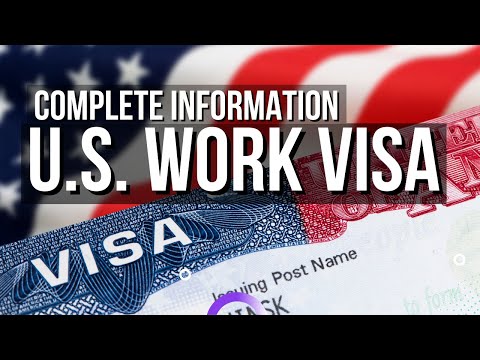Advertisements
Securing a work visa in the United States can be a pivotal step toward pursuing career opportunities, advancing professional goals, and experiencing life in a diverse and dynamic country. Whether you’re seeking temporary employment or aiming for long-term residency, navigating the intricacies of the U.S. immigration system is essential.
Advertisements
Understanding USA Work Visas
Understanding USA work visas is essential for individuals seeking employment opportunities in the United States. These visas allow foreign nationals to work temporarily in the U.S. for a specific employer, occupation, and duration.
The Significance of USA Work Visas
USA work visas hold significant importance for both employers and foreign nationals seeking employment opportunities in the United States. Understanding their significance is crucial for navigating the complex landscape of immigration and employment in the U.S. Here are some key points highlighting the significance of USA work visas:
- Access to Talent: Work visas allow U.S. employers to access a diverse pool of talent from around the world. Many industries, such as technology, healthcare, finance, and academia, rely on skilled foreign workers to fill specialized roles and address labor shortages.
- Economic Growth: Skilled foreign workers contribute to the U.S. economy by driving innovation, entrepreneurship, and productivity. Their expertise and contributions help fuel economic growth, create jobs, and enhance competitiveness in the global marketplace.
- Global Competitiveness: In an increasingly interconnected world, attracting top talent from abroad is essential for maintaining the United States’ competitiveness on the global stage. Work visas enable U.S. companies to remain at the forefront of innovation and maintain their leadership in key industries.
- Cultural Diversity: Work visas facilitate cultural exchange and diversity in the U.S. workforce. Foreign workers bring unique perspectives, experiences, and skills that enrich the workplace and foster a more inclusive and vibrant professional environment.
- Fill Skill Gaps: Work visas address skill gaps in the U.S. labor market by allowing employers to recruit individuals with specialized skills, knowledge, and expertise that may be in short supply domestically. This helps companies meet their workforce needs and sustain growth.
- Job Creation: By attracting foreign talent, work visas indirectly contribute to job creation in the United States. Foreign workers often create new businesses, invest in the local economy, and hire American workers, thereby stimulating economic activity and employment opportunities.
- International Collaboration: Work visas promote international collaboration and knowledge exchange by facilitating the movement of professionals across borders. This fosters partnerships between U.S. and foreign companies, research institutions, and academic organizations, leading to advancements in various fields.
- Career Opportunities: For foreign nationals, USA work visas offer valuable career opportunities and professional development prospects. Working in the United States allows individuals to gain exposure to new technologies, practices, and networks, enhancing their skills and advancing their careers.
- Family Reunification: Many work visas permit accompanying family members to join the primary visa holder in the United States. This enables families to reunite, experience new cultures, and pursue educational and employment opportunities together.
- Path to Permanent Residency: Some work visas serve as a pathway to permanent residency (green card) in the United States. For foreign workers seeking long-term settlement, obtaining a work visa can be a crucial step toward achieving their immigration goals and building a future in the U.S.
In summary, USA work visas play a vital role in facilitating employment opportunities, driving economic growth, fostering cultural diversity, and promoting international collaboration. They benefit employers, foreign workers, and the U.S. economy as a whole, underscoring their significance in the broader context of immigration and global workforce mobility.
Types of USA Work Visas
There are several types of USA work visas available for foreign nationals seeking employment opportunities in the United States. Each visa category is designed to accommodate different types of workers, industries, and employment circumstances. Here are some of the most common types of USA work visas:
- H-1B Visa: The H-1B visa is one of the most popular work visas for skilled workers in specialty occupations. It is typically sought after by professionals in fields such as information technology, engineering, healthcare, finance, and science. To qualify for an H-1B visa, applicants must possess a relevant bachelor’s degree or equivalent experience and have a job offer from a U.S. employer.
- L-1 Visa: The L-1 visa is for intracompany transferees who work for a multinational company with offices in the United States and abroad. It allows employees to transfer from a foreign branch, subsidiary, affiliate, or parent company to a U.S. office in an executive, managerial, or specialized knowledge capacity.
- O Visa: The O visa is reserved for individuals with extraordinary ability or achievement in specific fields, including science, education, business, athletics, and the arts. It is divided into three categories: O-1A for individuals with extraordinary ability in sciences, education, business, or athletics; O-1B for individuals with extraordinary ability in the arts or extraordinary achievement in the motion picture or television industry; and O-2 for individuals who will accompany and assist an O-1 visa holder in a specific event or performance.
- E Visa: The E visa is available for treaty traders (E-1) and treaty investors (E-2) from countries that have a qualifying treaty of commerce and navigation with the United States. E-1 visas are for individuals engaged in substantial trade between the U.S. and their home country, while E-2 visas are for investors who have made a substantial investment in a U.S. enterprise.
- TN Visa: The TN visa is available for professionals from Canada and Mexico under the provisions of the North American Free Trade Agreement (NAFTA). It allows individuals to work in certain designated professions, such as engineers, scientists, teachers, and management consultants, without the need for employer sponsorship.
- J-1 Visa: The J-1 visa is for individuals participating in exchange visitor programs sponsored by educational and cultural institutions, government agencies, and private sector organizations. It includes categories such as research scholars, professors, interns, trainees, and au pairs, among others.
- H-2B Visa: The H-2B visa is for temporary non-agricultural workers who will fill seasonal or peak-load positions that cannot be filled by U.S. workers. It is commonly used in industries such as hospitality, landscaping, construction, and manufacturing.
- H-3 Visa: The H-3 visa is for individuals coming to the United States for training or education that is not available in their home country. It is typically used by employers to provide job-related training to foreign nationals.
These are just a few examples of the types of USA work visas available to foreign workers. Each visa category has specific eligibility requirements, application procedures, and limitations, so it’s essential to carefully evaluate the options and consult with immigration professionals to determine the best fit for individual circumstances.
USA Work Visa Eligibility Criteria
Eligibility criteria for USA work visas vary depending on the specific visa category and the applicant’s circumstances. However, there are some common requirements and considerations that apply to many types of work visas. Here’s an overview of the key eligibility criteria for USA work visas:
- Job Offer from a U.S. Employer: Most USA work visas require a job offer from a U.S. employer who is willing to sponsor the foreign worker. The employer must demonstrate the need for foreign talent and comply with relevant labor laws and regulations.
- Qualifications and Experience: Applicants for USA work visas typically need to possess the necessary qualifications, skills, and experience required for the job they are applying for. This may include educational credentials, professional certifications, and relevant work experience.
- Specialty Occupation: Some work visas, such as the H-1B visa, are reserved for individuals working in specialty occupations that require specialized knowledge and skills. Applicants must demonstrate that their job falls within the designated specialty occupation category.
- Employer Sponsorship and Petition: In most cases, the U.S. employer must file a petition or application on behalf of the foreign worker with the U.S. Citizenship and Immigration Services (USCIS) or another relevant government agency. The employer is responsible for providing supporting documentation and demonstrating the need for the foreign worker.
- Labor Certification: For certain work visas, such as the H-2B visa, employers may be required to obtain a labor certification from the U.S. Department of Labor (DOL). This process involves demonstrating that there are no qualified U.S. workers available to fill the position and that hiring a foreign worker will not adversely affect the wages and working conditions of U.S. workers.
- English Language Proficiency: Depending on the visa category and the nature of the job, applicants may need to demonstrate proficiency in the English language. This is particularly important for visas that involve interaction with English-speaking clients, colleagues, or customers.
- Health and Character Requirements: Applicants for USA work visas may be required to undergo medical examinations and provide evidence of good character and conduct. This may include obtaining police clearance certificates or other relevant documents.
- Financial Support: Some work visas require evidence of financial support to cover living expenses, healthcare costs, and other expenses during the stay in the United States. This may include proof of sufficient funds or a commitment from the employer to provide financial support.
- Compliance with Visa Regulations: Applicants must demonstrate their intention to comply with the terms and conditions of the visa, including maintaining legal status, adhering to visa restrictions, and abiding by U.S. immigration laws.
- Dependent Visa Considerations: If the applicant plans to bring family members to the United States, additional requirements may apply for dependent visas. Spouses and unmarried children under a certain age may be eligible for derivative visas to accompany the primary visa holder.
It’s important to note that eligibility criteria may vary depending on the specific visa category and individual circumstances. Applicants should carefully review the requirements for their chosen visa category and seek guidance from immigration professionals to ensure they meet all eligibility criteria before applying.
The Application Process for USA Work Visas
Initial Steps
Embarking on the application process for a USA work visa demands thoroughness and patience. Here’s a breakdown of the preliminary steps to get you started:
- Secure a job offer: Your journey begins with securing a job offer from a US employer willing to sponsor your work visa.
- Petition filing: In many cases, the US employer must initiate the process by filing a petition with the United States Citizenship and Immigration Services (USCIS) on behalf of the foreign employee.
Completing the Visa Application
After the petition garners approval, the subsequent steps involve:
- Filling out the visa application form tailored to your visa category.
- Assembling all necessary supporting documents, including educational certificates, a job offer letter, and more.
- Settling the visa application fee, which varies depending on the visa type.
Attend a Visa Interview
Following the submission of your application and supporting documents, you’ll be summoned to attend a visa interview at a US embassy or consulate in your home country. During this session, a consular officer will scrutinize your application, conduct a background check, and assess your qualifications and eligibility.
Visa Approval and Issuance
Upon approval of your visa application, you’ll be bestowed with a visa stamp in your passport, granting you legal entry into the United States for your designated job.
Visa Expiry and Renewal
The duration of your USA work visa hinges on the specific visa category. While some visas are issued for a fixed term, others offer renewal options provided you meet the ongoing eligibility criteria. It’s imperative to initiate the visa renewal process before your current visa expires.
Challenges and Considerations
Visa Quotas and Limitations
Certain USA work visas, such as the H-1B visa, operate under annual quotas, rendering them fiercely competitive. Meeting the quota for a particular fiscal year can pose a hurdle to securing a work visa.
Visa Processing Times
Processing times for USA work visas fluctuate widely, spanning from a few months to over a year, contingent upon the visa category and your home country. It’s crucial to strategize and apply well in advance of your intended start date.
Legal Assistance
Given the intricacies of the US immigration system, many applicants opt for legal counsel to ensure the accuracy of their applications and address any legal complexities that may arise.
Dependents
Several USA work visas accommodate dependents, such as spouses and children, allowing them to accompany the primary visa holder. These dependents may also be eligible to work or study in the United States.
Maintaining Your Status
Upon entering the United States on a work visa, it’s paramount to adhere to the visa’s terms and conditions. This entails maintaining employment with your sponsoring employer and abiding by any visa-specific regulations. Should you contemplate changing jobs or employers, you may need to initiate a new visa application or transfer your existing visa.
Conclusion
Securing a USA work visa is a pivotal step toward realizing your career aspirations and tapping into the opportunities that the United States offers. While the process may be arduous, meticulous planning, attention to detail, and a clear comprehension of the visa requirements can pave the way for a successful navigation of the system. Whether your ambitions lie in the tech realm, financial sector, or beyond, obtaining a USA work visa is the gateway to materializing your professional ambitions. In this comprehensive guide, we’ve delved into the various types of USA work visas, their eligibility criteria, the application process, and pertinent considerations. Remember, each visa category entails unique requisites, so thorough research and consultation with USCIS are paramount for embarking on your chosen work visa path.




